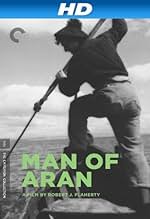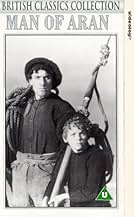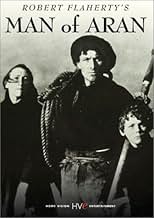IMDb-BEWERTUNG
7,1/10
2432
IHRE BEWERTUNG
Füge eine Handlung in deiner Sprache hinzuIn this blend of documentary and fictional narrative from pioneering filmmaker Robert Flaherty, the everyday trials of life on Ireland's unforgiving Aran Islands are captured with attention ... Alles lesenIn this blend of documentary and fictional narrative from pioneering filmmaker Robert Flaherty, the everyday trials of life on Ireland's unforgiving Aran Islands are captured with attention to naturalistic beauty and historical detail.In this blend of documentary and fictional narrative from pioneering filmmaker Robert Flaherty, the everyday trials of life on Ireland's unforgiving Aran Islands are captured with attention to naturalistic beauty and historical detail.
- Regie
- Drehbuch
- Hauptbesetzung
- Auszeichnungen
- 3 wins total
Empfohlene Bewertungen
If you were to ask passers-by on the street if they'd be interested in seeing a 1934 documentary about the harsh day-to-day existence of a tiny community living on a remote island off the coast of Ireland -- well, you'd be standing there all day before you could find someone who'd say, "sure!". Which is really a disappointment because they don't know what they're missing!
Think of every poem you've read about the sea and man's relation to it and you might get a clue as to the depths of feeling that this film has. It's like Hemingway, Pablo Neruda and W.B. Yeats all rolled into one. It's extremely simplistic, just shots of how a small family fishes, hauls seaweed for fertilizer (there is no soil on the island) and dodges waves so high that its foam sprays above the cliff-tops. Not to mention an incredible sequence where five fishermen try to catch and kill a shark that is a good deal larger than their boat!
What's most exhilarating about this film is that while you're watching it, you can't help but think that these people are crazy to choose to live in such a desolate and difficult place, but then you try to imagine them elsewhere and you know that they are as much a part of that environment as the stubborn sea-worn cliffs are. After even thirty minutes of the film, the roar of the ocean and the cries of the gulls fill your head to such an extreme that you know that such people could live no where else. This film is reminiscent of Roberto Rossellini's film, "Stromboli" about the inhabitants of a small village on a volcanic island. There are a few brief pockets of sentimentality due to the score, but the filmmakers thankfully left out the music during all of the film's most important scenes. Overall what you have is an incredible cinematic experience that makes you think and imagine what it would be like to live a life where every day is a struggle with the elements of nature and a fight for survival, yet filled with the deepest awe and respect for nature and for living.
Think of every poem you've read about the sea and man's relation to it and you might get a clue as to the depths of feeling that this film has. It's like Hemingway, Pablo Neruda and W.B. Yeats all rolled into one. It's extremely simplistic, just shots of how a small family fishes, hauls seaweed for fertilizer (there is no soil on the island) and dodges waves so high that its foam sprays above the cliff-tops. Not to mention an incredible sequence where five fishermen try to catch and kill a shark that is a good deal larger than their boat!
What's most exhilarating about this film is that while you're watching it, you can't help but think that these people are crazy to choose to live in such a desolate and difficult place, but then you try to imagine them elsewhere and you know that they are as much a part of that environment as the stubborn sea-worn cliffs are. After even thirty minutes of the film, the roar of the ocean and the cries of the gulls fill your head to such an extreme that you know that such people could live no where else. This film is reminiscent of Roberto Rossellini's film, "Stromboli" about the inhabitants of a small village on a volcanic island. There are a few brief pockets of sentimentality due to the score, but the filmmakers thankfully left out the music during all of the film's most important scenes. Overall what you have is an incredible cinematic experience that makes you think and imagine what it would be like to live a life where every day is a struggle with the elements of nature and a fight for survival, yet filled with the deepest awe and respect for nature and for living.
This review is being written by a man who absolutely despises everything about realist style films. However, Flaherty's depiction of life on the Isle of Aran captivated me from start to finish. Filled with inaccuracies and misrepresentations, Flaherty would have been lying through his teeth to have called this a documentary (the man of Aran wasn't even from Aran). Man of Aran remains realist however in that, I believe, in that it only speaks to you if you hold a connection to the sort of life it depicts. Flaherty brings forth the essence of that life but will only hold your interest if you actually care how someone might farm in a soilless field of broken rock.
If that isn't your bag, you can still at least enjoy Flaherty's visuals. Waves pound against rocky cliffs sending spray a hundred feet high. It is quite a spectacle.
If that isn't your bag, you can still at least enjoy Flaherty's visuals. Waves pound against rocky cliffs sending spray a hundred feet high. It is quite a spectacle.
As a child, I saw Man of Aran in my grandfather's living room. I didn;t understand why he seemed so moved by the Man of Aran. I recently learned that Colman King (the star) was my grandfather's first cousin. Delia King Donahue was my great grandmother, and her nephew was Colman King. As far as the film goes, it is what it is, the life and times of those trying to eek out a living under very adverse circumstances.
Does anyone know where I might obtain a poster(reproduction) of the movie? Yah, nostalgia)
Thanks, Sue
Does anyone know where I might obtain a poster(reproduction) of the movie? Yah, nostalgia)
Thanks, Sue
Next time you feel the need to gripe, complain, sit-back, loaf and refuse to get-up and get going, you need to watch this movie which expertly makes the point of you don't work you don't eat and it is not a threat but a reality. You got people living on what amounts to a giant rock of an island trying to make it all make sense in huts with weather, hardships and work being your everyday challenge to exist. If you enjoy it and it appears that they do, then they are living out their lives to their satisfaction. Nice shots of the background and how people respect what they have and become good stewards of it. It appears getting wet and cold is the price to pay for living and working on this island. Some fascinating events and surprises come-up of which I wont mention that cause intrigue and capture the viewer every step of the way. I had a couple of moments where I said "so that's what is going on and why they do that" which were very enjoyable. Remember, this movie goes back decades ago in a remote place meaning, no 7-11, TV, phones, Internet or bar visits. You work from sun-up to sun-down and retire to your little hut where animals, a hot liquid and rest awaits. Working together is a must or it gets even worse too. This is very well demonstrated. Good movie to snack with or have a sandwich with a tasty drink. Stop complaining about anything and everything and see how others live and love with less...
We had jounced across Galway bay in a 45 minute ferry ride, boarded a pony trap for an hour's ride in a two-wheeled carriage, upholstered with leather and duct tape and driven by an ancient Irishman named Tom Flaherty, whose first language was Gaelic. He deposited us at the Atlantic side of the island at a tiny museum for break. My husband opted for the hike to the headland to view a crumbling 20th century fort, while I browsed the museum. It was there that I spied a poster for "Man of Aran" - only 2.50 Euros per person. It sounded vaguely interesting, a way to pass time til the pony trap driver returned to take us bouncing back to the ferry boat landing.
We climbed the steep stairs and were seated in a room overlooking the centuries old stone walls that crawl haphazardly over the rugged terrain. A large high definition television sat before us, and we waited for the lady at the downstairs desk to come turn it on. We were joined by four more people, the blinds were drawn and the warbly, scratchy sound track and grainy black and white documentary began. We were gripped immediately by the story - part adventure, part documentary, part drama. It was easy to believe the severe conditions, the arduous, back breaking work of gathering kelp, fishing in the heaving surf, rocky, slippery shores, having just witnessed them in person. A few of the scenes are a little fakey, but we're talking 1934 here, and if you'd ever seen that pounding surf at the foot of that towering cliff, you'd know why they perhaps went Hollywood in the shark hunting scene. If you can't see it in its place of origin, by all means make the effort to find a print. This is a classic. By the way, our driver, Tom Flaherty, would have been 12 years old when the film was made but the director/producer Flaherty was an American from Hollywood, and much distrusted by the natives. He had one heck of a time making the movie, so the brochure at the desk informed us. In typical local resident style, our driver had never seen the movie and did not claim to be related to the director. He dropped us at the ferry and, speaking endearing terms in Gaelic to Brownie, his faithful cart horse, urged her back up the path to the pub for his daily pint of Guinness.
We climbed the steep stairs and were seated in a room overlooking the centuries old stone walls that crawl haphazardly over the rugged terrain. A large high definition television sat before us, and we waited for the lady at the downstairs desk to come turn it on. We were joined by four more people, the blinds were drawn and the warbly, scratchy sound track and grainy black and white documentary began. We were gripped immediately by the story - part adventure, part documentary, part drama. It was easy to believe the severe conditions, the arduous, back breaking work of gathering kelp, fishing in the heaving surf, rocky, slippery shores, having just witnessed them in person. A few of the scenes are a little fakey, but we're talking 1934 here, and if you'd ever seen that pounding surf at the foot of that towering cliff, you'd know why they perhaps went Hollywood in the shark hunting scene. If you can't see it in its place of origin, by all means make the effort to find a print. This is a classic. By the way, our driver, Tom Flaherty, would have been 12 years old when the film was made but the director/producer Flaherty was an American from Hollywood, and much distrusted by the natives. He had one heck of a time making the movie, so the brochure at the desk informed us. In typical local resident style, our driver had never seen the movie and did not claim to be related to the director. He dropped us at the ferry and, speaking endearing terms in Gaelic to Brownie, his faithful cart horse, urged her back up the path to the pub for his daily pint of Guinness.
Wusstest du schon
- WissenswertesThe islanders hunt a basking shark for its oil, but they hadn't done so in generations. The filmmakers had to bring an Inuit hunter to show them how to do it as their ancestors might have.
- Alternative VersionenThere is an Italian edition of this film on DVD, distributed by DNA srl, "L'UOMO DI ARAN (1934), NANUK L'ESCHIMESE (1922), OMBRE BIANCHE NEI MARI DEL SUD (1928)" (3 Films on a single DVD), re-edited with the contribution of film historian Riccardo Cusin. This version is also available for streaming on some platforms.
- VerbindungenEdited into Spisok korabley (2008)
Top-Auswahl
Melde dich zum Bewerten an und greife auf die Watchlist für personalisierte Empfehlungen zu.
Details
- Laufzeit
- 1 Std. 16 Min.(76 min)
- Farbe
- Sound-Mix
- Seitenverhältnis
- 1.37 : 1
Zu dieser Seite beitragen
Bearbeitung vorschlagen oder fehlenden Inhalt hinzufügen






















